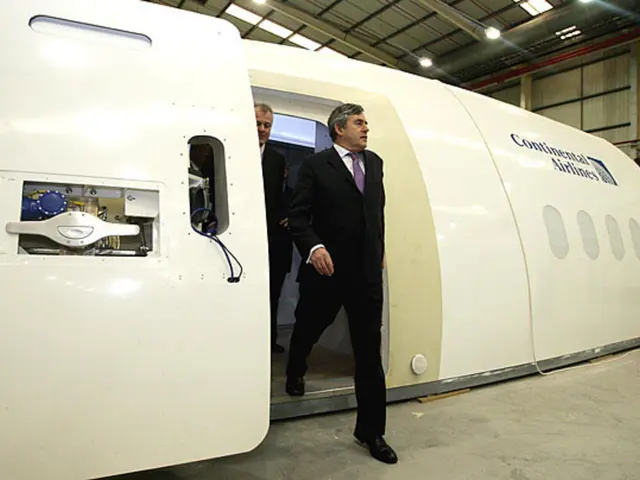Analyze the Overarching Business Landscape: Six key PESTEL Factors that Boost Corporate Prosperity
The dynamic macro-environment presents businesses with a constantly shifting landscape of challenges and opportunities. While demographic shifts often unfold over a prolonged period, other factors such as technology and the economy can be highly volatile.
Globalization, for instance, has entwined economies worldwide. A financial crisis in one nation, such as the 2008 recession, can swiftly spread to other countries, creating a cascading effect. This interconnection emphasizes the essential significance of a global outlook for companies.
Technological advancements serve as a formidable driving force behind change. The ongoing digital revolution is restructuring industries, from overturning traditional retail models to launching innovative business concepts like ride-hailing services. To navigate this ever-changing technological landscape, companies must exhibit agility and adaptability.
To ensure success, understanding a company's macro-environment is paramount. The macro-environment refers to the broad external factors that influence a company's operations, beyond its control. These factors can significantly impact its competitive landscape and internal environment, even with minor changes.
Here's a summary of the environments surrounding a business:
- Macro-environment: External, uncontrollable factors like economic trends, technological advancements, and social changes.
- Competitive environment: External stakeholders a company interacts with, including competitors, suppliers, customers, and governmental regulations.
- Internal environment: Internal factors within a company it can control, such as its organizational structure, resources, and company culture.
A thorough examination of the macro-environment is a vital tool for any business seeking long-term success. This external landscape shapes the foundation on which companies operate. By carefully analyzing these uncontrollable factors, businesses can make informed strategic decisions, unveiling potential opportunities and threats early on.
A comprehensive macro-environment analysis empowers businesses in the following ways:
- Identifying opportunities and threats: The macro-environment is perpetually offering a fluid mix of potential benefits and challenges. A comprehensive analysis allows businesses to recognize these opportunities and threats promptly. For example, a food and beverage company might capitalize on a growing trend toward plant-based diets within the sociocultural macro-environment. On the other hand, a company heavily dependent on fossil fuels might prepare for stricter environmental regulations.
- Strategic decision-making for the future: Companies that grasp the macro-environment can make strategic decisions with a long-term perspective. By anticipating future trends in areas such as technology, economics, and government policies, companies can proactively adapt their strategies to navigate the evolving landscape.
The macro-environment can be analyzed using the acronym PESTEL, which represents six key factors that significantly influence a company's operations:
- Political factors
- Economic factors
- Socio-cultural factors
- Technological factors
- Environmental factors
- Legal factors
It's essential to remember that these factors can be local, national, or global. Consequently, their impact will differ across various businesses. For instance, economic factors like imposed trade barriers are global concerns that may affect export-oriented domestic companies more significantly compared to businesses relying on local sales.
Political factors
The political landscape plays a significant role in the macro-environment. Shifts in government policies, leadership, and regulations can create both unforeseen challenges and opportunities for businesses.
- Policy shifts: New legislation or modifications to existing laws can directly impact a company's operations. For instance, stricter environmental regulations might necessitate investments in cleaner production processes for manufacturing companies.
- Taxation: Government tax policies can significantly impact a company's profitability through corporate tax rates, import/export duties, or tax incentives for specific industries.
- Political instability: Political instability and uncertainty can create a challenging business environment, potentially causing interruptions due to demonstrations, riots, or policy changes originating from unstable governments.
- Global trade: Governmental policies concerning international trade agreements, tariffs, and sanctions can all influence a company's ability to import and export goods. Awareness of a trading partner country's political climate is vital for businesses engaged in global operations.
Economic factors
The economic landscape is a fundamental pillar within the macroenvironment. These factors exert a substantial influence on business performance. To deepen comprehension, let's explore some crucial economic components and their impact.
- Economic growth: A robust economy, characterized by expanding GDP, tends to encourage consumer spending and business investment, creating a favorable environment for businesses to expand and generate profits. In contrast, an economic downturn can lead to reduced spending, higher unemployment, and overall economic stagnation, posing difficulties for businesses.
- Inflation: Inflation corresponds to the rising price of goods and services over time. Moderate inflation can be manageable, but high inflation erodes consumer purchasing power, thereby reducing overall demand for goods and services. Businesses must adjust their pricing strategies and cost structures to cope with inflation effectively.
- Interest rates: Interest rates set by central banks influence borrowing costs for businesses and consumers. Higher interest rates make borrowing more expensive, potentially leading to reduced investment and economic activity. On the contrary, lower interest rates can stimulate borrowing and investment, fostering economic growth.
- Exchange rates: Changes in exchange rates can significantly impact businesses involved in international trade. A strong domestic currency can make exports less competitive in foreign markets, while a weak domestic currency can make imports more expensive. Companies must be aware of exchange rate fluctuations and implement strategies to address potential risks.
- Government policies: Government policies, including fiscal policy (taxation and spending) and monetary policy (interest rates), can influence the economic environment directly or indirectly. Understanding these policies aids businesses in anticipating potential changes and adjusting their strategies accordingly.
Socio-cultural factors
Socio-cultural factors within the macro-environment highlight social trends and values that drive consumer behavior. By understanding these dynamics, businesses can gain a crucial advantage in connecting with their target audience and crafting successful strategies.
- Demographics: Changes in population characteristics, such as age distribution, income levels, and educational attainment, play a role in shaping consumer needs and preferences. For example, an aging population can provide an opportunity for businesses to develop products and services catering to seniors' needs, such as retirement homes or healthcare solutions.
- Social values and lifestyles: Shifts in social values, like a growing emphasis on environmental consciousness or health and wellness, can influence consumer tastes. Companies that align their products and practices with evolving social values are more likely to appeal to their target market.
- Consumer behavior: Socio-cultural factors substantially impact how consumers spend their money. Analyzing these patterns enables businesses to develop targeted marketing campaigns, product offerings, and pricing strategies. As an example, the rise of the middle class in developing economies signifies a vast potential market for companies offering discretionary goods and services.
The influence of socio-cultural factors extends beyond consumer spending. These factors can also impact:
- Workforce demographics: The demographics and cultural values of the workforce can shape a company's talent pool and employee expectations.
- Business practices: Social norms and ethical considerations can influence a company's approach to areas like labor practices, environmental sustainability, and corporate social responsibility.
Technological factors
The relentless technological evolution perpetually transforms the macro-environment. Technological advancements serve as a potent force for disruption and innovation, impacting businesses across all industries.
- Disruptive technologies: The emergence of new technologies can disrupt entire industries. For example, the rise of e-commerce has placed significant pressure on traditional brick-and-mortar retail businesses, compelling them to adapt their strategies to survive in the online marketplace.
- Improved production techniques: Technological advancements streamline production processes, leading to increased efficiency and cost savings. Companies that leverage automation, artificial intelligence, and other advanced manufacturing techniques gain a competitive advantage.
- Evolving communication channels: Technology revolutionizes communication, providing new ways for businesses to interact with customers and stakeholders. Social media platforms, mobile apps, and cloud-based collaboration tools are vital elements of modern communication strategies.
- New business models: Technological innovation generates the emergence of entirely new business models. Companies such as Uber have disrupted traditional industries by employing technology to form innovative service offerings.
The technological landscape isn't limited simply to physical manifestations like the Internet or 3D printers. The research and development (R&D) surrounding these advancements are equally essential. Companies that prioritize continuous innovation and invest heavily in R&D are better equipped to remain ahead of the technological curve and capitalize on emerging trends within the macro-environment.
Environmental factors
The macro-environment increasingly compels businesses to address environmental concerns, which encompass natural resources, the physical environment, and ecological conditions. Ignoring their growing importance can lead to substantial risks.
- Resource management: Businesses are increasingly scrutinized for their allocation of natural resources. Sustainable practices like waste reduction, resource conservation, and efficient energy consumption are becoming crucial for long-term business success. Companies that prioritize environmental stewardship attract environmentally conscious consumers and investors.
- Climate change and natural disasters: The escalating threat of climate change poses significant challenges for businesses. Extreme weather events, rising sea levels, and resource scarcity can disrupt supply chains, damage infrastructure, and create logistical difficulties. Companies must develop strategies to mitigate these risks and build resilience in their operations.
- Government regulations: Governments worldwide implement stricter environmental regulations to address climate change and pollution issues. These regulations can affect businesses by requiring cleaner production processes and mandating the usage of recycled materials. Businesses need to stay informed about evolving regulations and adapt their practices accordingly.
- Shifting consumer preferences: Consumers are becoming more environmentally aware, influencing the products they purchase. Companies that offer sustainable and eco-friendly products and services are better positioned to captivate this growing consumer segment.
Legal factors
The intricate macro-environment sets the ground rules that businesses must operate within. These factors are inextricably linked to political factors, as changes in government can result in shifts in legislation and regulations.
- Compliance burden: Businesses need to navigate a complex web of laws and regulations pertaining to various aspects of their operations. Laws covering aspects such as competition, labor practices, consumer protection, product safety, and environmental sustainability impact businesses. Neglecting to comply with these regulations can result in fines, legal repercussions, and reputational damage.
- Fair market competition: Legal frameworks promote fair competition within an industry. Antitrust laws deter monopolies and ensure a level playing field for all businesses. Grasping these competition laws is vital for companies to develop strategies that adhere to regulations while gaining a competitive advantage.
- Labor regulations: Labor laws govern aspects such as minimum wage, working hours, and employee benefits. Businesses must adhere to these regulations to maintain a compliant and ethical workplace environment. Additional, evolving labor laws, including those pertaining to remote work or data privacy, require businesses to adapt their human resources practices accordingly.
- Consumer protection: Consumer protection laws protect consumers' interests and rights. Businesses must comply with regulations regarding product labeling, advertising practices, and data privacy to avoid legal repercussions and maintain consumer trust.
How the macro-environment affects businesses
Changes within the macro-environment can have far-reaching effects on various aspects of a business. Below, we delve deeper into the impact in three key areas:
- Strategic planning: Effective strategic planning necessitates businesses to consider the macro-environment. For example, by analyzing economic trends like interest rates, a company can make informed decisions regarding resource allocation, investments, and strategic partnerships. By anticipating changes in the macro-environment, businesses can make proactive decisions to achieve long-term sustainability.
- Profitability: Business profitability depends on a company's ability to adapt to a dynamic marketplace. Fluctuations in the macro-environment, such as inflation or changes in consumer spending patterns, can directly impact a company's bottom line. Businesses that can tweak their pricing strategies, operating costs, or product offerings to accommodate these external factors can maintain their financial health and grow.
- Operations: The macro-environment encompasses legal regulations, technological advancements, and environmental concerns that influence a company's day-to-day operations. Businesses must monitor these developments and update their processes to ensure compliance and efficiency. For example, a company in the food and beverage industry might need to invest in new equipment or modify its production processes to comply with stricter environmental regulations.
Case Study: The Insurance Industry and the Macro-environment
Let's explore an illustrative case: the insurance industry. Insurance companies rely on both premium income and investment income to generate profits. Here's how the macro-environment comes into play:
- Economic indicators: Insurance companies closely scrutinize economic indicators like stock prices, bond yields, interest rates, and economic growth. These indicators influence the potential return on investments and the associated risks. Analyzing these trends allows insurance companies to make informed investment decisions.
- Investment decisions: Based on their macro-environment analysis, insurance companies can make strategic asset allocation decisions. For example, if they anticipate rising interest rates, they might reduce their bond holdings because bond prices typically decrease when interest rates rise. This proactive approach helps them achieve optimal returns while managing risk.
The impact of the macro-environment is not limited to the insurance industry. Companies across all industries need to understand these external forces and adapt their strategies to prosper in a dynamic and ever-changing world. By staying informed about trends in the macro-environment and responding accordingly, companies can position themselves for long-term success.
Not Only Strategic
While the macro-environment offers a complex web of interconnected factors, it's essential to recognize that these factors do not impact all industries evenly. Not all factors possess equal strategic importance for every business. Here's why a targeted approach proves vital:
Varying Industry Exposure
For every industry, some macro-environmental factors have greater impact than others. For instance:
- Interest rates: The banking industry experiences a profound impact from interest rate shifts. Changes in interest rates significantly affect banking margins, loan rates, and overall investment strategies. Conversely, the manufacturing industry may encounter a less direct impact, with the rise in borrowing costs for expansion projects representing less of a burden.
- Inflation: Rising inflation poses a significant concern for food and beverage companies, whose costs for raw materials rise, thereby pressuring them to raise their product prices. Utility companies, on the other hand, may possess more control over their pricing structures through regulatory frameworks and may be less affected by inflation in the short term.
Focusing On Strategic Significance
When examining the macro-environment, businesses must focus on pinpointing the factors that have the most significant impact on their specific operations and profitability. A targeted approach alongside a sharp strategic focus enables businesses to allocate resources optimally and navigate the macro-environment effectively.
For example, a retail company might prioritize analyzing consumer spending patterns and demographic shifts within the macro-environment's sociocultural factors. These factors directly influence customer demand for its products. Gaining insights into these trends lets the retailer customize its product offerings, marketing strategies, and store locations to better meet customer preferences.
A Dynamic Landscape, Strategic Focus
The macro-environment continually evolves. While some factors may present immediate advantages or challenges, others may influence the business landscape over a longer time frame. By consistently monitoring these changes and focusing on the most strategically relevant factors, businesses can adapt effectively and prosper in a dynamic world.
A company in the technology sector, for example, would keenly observe economic factors like growth and inflation. However, technological advancements might possess a more vital strategic relevance. By staying abreast of the latest tech trends and potential disruptions, this company can proactively adapt its products and services to stay ahead of the curve and maintain a competitive edge.
[1] Economic Environment: Impact on Businesses, Investments & Growth (Key Factors). (n.d.). Retrieved August 26, 2023, from https://www.investopedia.com/terms/m/macroeconomyeffectbizops.asp
[2] Political Environment: Key Considerations for Business and Investment Decisions. (2021). Retrieved August 26, 2023, from https://www.investopedia.com/terms/p/politicalriskanalysis.asp
[3] Understanding the Economic Landscape: How Macroeconomic Factors Impact Business. (2019, September 18). Retrieved August 26, 2023, from https://smallbusiness.chron.com/understand-economic-landscape-macroeconomic-factors-impact-business-35196.html
[4] Understanding the Business Environment: A Framework for Strategic Analysis. (n.d.). Retrieved August 26, 2023, from https://www.strategy4business.com/Article/Understand-Business-Environment--Framework-for-Strategic-Analysis-3114
[5] Business Success From Within: A Guide to Internal Environment. (n.d.). Retrieved August 26, 2023, from https://www.strategy4business.com/Article/Business-Success-from-Within-Guide-to-Internal-Environment-8774
[6] External Environment: Understanding External Factors Impacting The Business Success. (n.d.). Retrieved August 26, 2023, from https://www.strategy4business.com/Article/External-Environment-Understanding-External-Factors-Impacting-The-Business-Success-8952
[7] Environmental Factors in Business: Impact, Risks and Opportunities. (n.d.). Retrieved August 26, 2023, from https://www.strategy4business.com/Article/Environmental-Factors-in-Business-Impact---Risks-and-Opportunities-7609
[8] Task Environment: Understanding the Industry's Competitive Landscape. (n.d.). Retrieved August 26, 2023, from https://www.strategy4business.com/Article/Task-Environment-Understanding-the-Industry-s-Competitive-Landscape-6318
[9] Shape Your Success: Navigating the Business Environment. (n.d.). Retrieved August 26, 2023, from https://www.strategy4business.com/Article/Shape-Your-Success-Navigating-the-Business-Environment-6322
- In the realm of finance and investing, understanding the macro-environment is crucial for companies to anticipate future trends in the economy, technology, and government policies, enabling them to make proactive, strategic decisions.
- Engaging in education and self-development, particularly in the areas of business and technology, can provide an edge for companies seeking to navigate the macro-environment effectively and capitalize on potential opportunities while mitigating threats.







